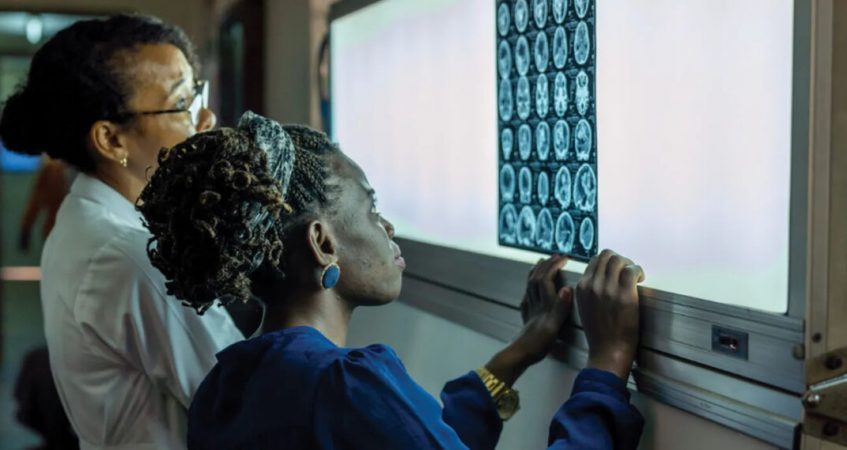Pediatric cancer in Africa, a silent killer

18/10/2021
by Cristina Cornelli, Director of the Soleterre Foundation, associated with the Link2007 network, for Africa Rivista
When it comes to health in Africa, the accent is almost always on infectious (HIV, malaria, etc.), neonatal, maternal and nutritional diseases (CMNN – communicable, maternal, neonatal and nutritional), which currently constitute the main cause of mortality. Over the years, however, the picture has changed considerably: for two decades the proportion of non-communicable diseases (cardiovascular diseases, cancers, diabetes and respiratory diseases) has been increasing and an article published in 2019 in the journal The Lancet predicts that by By 2030, non-communicable diseases will overtake CMNNs as the leading cause of death in sub-Saharan Africa.
Globally, non-communicable diseases already represent the leading cause of mortality: there are 41 million deaths annually, which correspond to 71% of all global deaths (of which 17.9 million from cardiovascular disease, 9 from cancer, 3 from 9 for respiratory diseases, 1.6 for diabetes). If we talk about cancer, especially pediatric cancer, thanks to the enormous progress made by medicine in recent decades, the survival rate for high-income countries is in the order of 80%. However, WHO estimates that of the 400,000 cases of pediatric cancer diagnosed globally each year, the majority come from low- and middle-income countries (LMICs)., where the survival rate is still extremely low: the rate varies by tumor type and region, but an estimate based on a microsimulation model indicates the 5-year net survival after diagnosis for East Africa all ‘8.1%.
The causes of the very low survival rate in Africa and in the LMIC countries are many, but one of the main ones lies in the fact that very often tumors are not diagnosed , or are diagnosed too late: it is currently estimated that one in two cases of pediatric cancer is not identified in sub-Saharan Africa due to health system-level limitations, which include difficulties in accessing treatment and diagnosis, as well as the referral process between peripheral facilities and central hospitals.
The study commissioned by Lancet Oncology predicts that between 2020 and 2050 there will be 13.7 million new cases of pediatric cancer and, without significant changes in health systems, 44% of these will go undiagnosed . This means that, based on current mortality rates, 11.1 million children will die of cancer, and 9.3 million of these (equal to 84.1% of the total) will be children living in low- and middle-income countries .
The reasons for these dire statistics , and for the huge gap between low- and middle-income countries versus high-income ones, are many. In addition to the structural causes intrinsic to the health systems of the former, there are also factors linked to the financial availability of the majority of the population: medicines and treatments for cancer are often not accessible due to cost issues. In rural areas or far from specialized hospitals, the transport costs for several cycles of therapy can be an obstacle. And with them also the costs of accommodation for periods extended over time (treatments on average last up to 6-8 months), often in the capital.
The remoteness of one’s own family and support means that many families are forced to go into debt or to sell their assets to meet extraordinary and unforeseen expenses . Finally, beliefs and legends persist in many societies which lead families of children with cancer to fear being stigmatized, or to not trust doctors and prefer traditional treatments. Practices that do nothing but delay the moment of diagnosis and thus decrease the chances of recovery.
Even among many health care professionals, strong misconceptions about the epidemiology and cure options of childhood cancers in low- and middle-income countries persist, misconceptions that in turn contribute to widening the disparities between survival rates in LMIC and non-LMIC countries. high-income. It is often thought that the number of cases of pediatric cancer is not significant in LMICs, that treatments are not accessible, and that they can subtract resources from the treatment of communicable diseases, or from other diseases for which more widely tested treatments exist.
The study commissioned by Lancet Oncology illustrates a range of effective, affordable policies and interventions aimed at improving access to care which, if applied individually, would contribute to a significant increase in survival rates in LMIC countries. Among the interventions deemed necessary is the improvement of access to basic health care and reference to higher level services, the improvement of social support services to reduce the abandonment of care, the expansion of availability and the quality of the cures. If applied on a large scale, holistically and simultaneously, it is estimated that the expected number of deaths would be reduced by more than half, avoiding the deaths of 6.2 million children between 2020 and 2050 , with the most significant reduction precisely in low- and middle-income countries.
In order to bridge the huge disparity in survival rates between high-income and low-middle-income countries, WHO launched the Global Initiative for Child Cancer (GICC) in September 2018. in low- and middle-income countries. The goal is to achieve, by 2030, the survival rate of 60% for the 6 main pediatric cancers (acute lymphoblastic leukemia, Burkitt’s lymphoma, Hodgkin’s lymphoma, retinoblastoma, Wilms’ tumor, low-grade glioma).
A challenge that can first of all be met by creating virtuous networks of several international organizations whose objective is to raise survival rates and improve the quality of life of children and adolescents with cancer. We need a multi-disciplinary intervention that looks both at the healthcare system in its complexity and at the psychological repercussions of the disease on patients and families. We need to work together, first and foremost, to combat the inequalities that still exist in access to cancer diagnosis and treatment.
